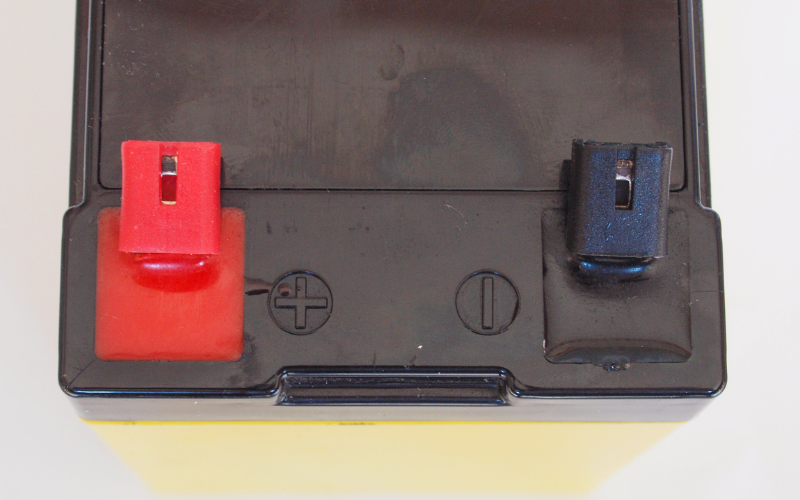When talking about lawn mower battery voltage, there is a bit of a range depending on the kind of lawn mower it is and the year it was made. Because of this, there isn’t just one answer to the question of how many volts a lawn mower battery is.
So to get down to the bottom of this question, it’s a good idea to look into what different lawn mower batteries are used for and some of the ways that you can identify their voltage.
In general, lawn mower batteries are used for one of two reasons: either to power the starter of a gas engine, or to actually power an electric motor. Let’s talk about some of the standard voltages in either case.

Lawn Mower Battery Voltage (The Short Answer)
The most important variable when it comes to lawn mower battery voltage is the type of mower in question. Riding lawn mower battery voltage is usually 12 volts for gas-powered models, but some older mowers use 6-volt batteries. Electric mowers on the other hand typically use lithium-ion batteries that range from 36 to 120 volts.
Push Lawn Mower vs Riding Lawn Mower Battery Voltage
Since we’ve already established that lawn mower batteries are used for either starting gas-powered engines, or powering electric motors, let’s talk in more detail about the differences between riding and push mower batteries. Riding lawn mowers that have gas engines use lead-acid batteries while push mowers (and electric riding mowers) usually use lithium-ion batteries.
The main differences between lead-acid and lithium-ion batteries are cost, range, and charging time. Lead-acid batteries are less expensive but they have a shorter lifespan and require more time to charge. Lithium-ion batteries are newer technology and they are lightweight, fast-charging, and can deliver more voltage.
Since riding mowers mainly use the battery to get started, they don’t need the added benefits of a lithium-ion battery. However, cordless push mowers and electric riding mowers rely on higher voltage lithium-ion batteries to deliver tons of power for a long period of time.
Because of this, you’ll find that most push mower batteries (or lithium-ion lawn mower batteries in general) tend to have almost 5 times the amount of voltage as riding lawn mower batteries.
How to Find Out How Many Volts a Lawn Mower Battery Is
Figuring out how many volts a lawn mower battery is can be done in a few different ways. Sometimes you get lucky and can find your battery’s voltage listed right on its side, but in other cases, a bit more investigation is required.
I’ll list some of the easiest ways to find out your lawn mower battery’s voltage below.
1. Inspect the Battery
In my experience the simplest way to answer the question of “how many volts is a lawn mower battery?” is to take a look at the battery itself. Nearly all batteries I’ve seen have a large label on one side that contains a lot of useful information.
You might notice a line of text that could say, for example, “12v7Ah”. This would mean that you have a 12-volt battery with 7 amp-hours. Whatever the case may be, just look for the number just before the “V” for volts.
Most lawn mowers that use lithium-ion batteries will advertise the amount of voltage the mower produces. The only thing to watch out for is sometimes cordless electric push mowers will use two batteries in tandem to produce a higher total voltage. So when looking at your lithium-ion batteries, make sure to take that into consideration.
2. Reference Owner’s Manual
Another trustworthy means of determining your battery’s voltage is to search your owner’s manual. You should be able to flip to the electrical or battery section without much difficulty and find out what type of battery your lawn mower uses. This works great for both mowers that use lead-acid batteries and mowers that use lithium-ion batteries.
3. Find Mower’s Serial Number
For those of you who don’t have an owner’s manual, or just can’t seem to find it, take a look at your mower’s deck for the serial and model number. Most of the time you can find these numbers on a small label stuck to the deck. This label may be hard to locate but usually, it is stuck to one of the sides of the deck, the front or rear of the mower, or on top of the deck just behind the engine.
Once you have the serial number, a quick internet search should bring you to your manufacturer’s page or pull up a digital owner’s manual you can reference.
4. Count Battery Cells
If you have a lead-acid battery, and you can’t find any information on your battery or lawn mower itself, counting the number of cells your battery has is a good trick. The cells on most lead-acid batteries are pretty easy to identify by the small plastic caps on the top of the battery. This is where the electrolyte and acid mixture is added to the battery.
Once you see the cells on your battery, count them. Each lead-acid battery cell will produce just over 2 volts. So, count the number of cells, multiply that number by 2, and that will give you the voltage. As an example, 12 volts batteries will have 6 cells whereas 6-volt batteries will only have 3.


Can I use a small 12 volt car battery in my gas powered 12volt lawnmower to power the starter on the gas engine?
Hi Billy John,
Car chargers are perfectly fine to use on lawn mower starter batteries as long as the charger matches your specific battery. For example, if your charger is designed to charge AGM batteries and you do, in fact, actually have an AGM battery on your lawn mower, you’ll be fine.
Now if you are trying to start your lawn mower that has a dead battery or a battery without enough power, then you’ll need to have a charger that can be used for starting. This isn’t something all chargers can do. You’ll need a charger that can produce enough CCA (Cold Cranking Amps). So a charger that doesn’t have an engine start feature isn’t going to be able to start your lawn mower. You’ll have to wait for the charger to charge the battery. Then the battery will have enough CCA’s to fire up your lawn mower.
Thanks for the question!
Tom.